Bitcoin Analysts Warn Taproot Wallets Face Quantum Risk

- Bitcoin users urged to protect both private and public keys amid rising quantum risks.
- Taproot addresses “bc1p” may expose wallets; SegWit “bc1q” offers safer short-term storage.
- Experts project Bitcoin’s quantum-resistant upgrade could roll out between 2028 and 2030.
Bitcoin experts are urging users to secure both private and public keys due to advances in quantum computing. Prominent analyst Willy Woo warned that Bitcoin’s taproot addresses, beginning with “bc1p,” expose public keys, leaving wallets vulnerable once quantum computers mature. The community expects a quantum-resistant Bitcoin upgrade by 2030, but custodians are advised to act now.
Bitcoin Users Told to Hide Public Keys
Woo, in a detailed X post, explained that while traditional crypto safety focused on protecting private keys, quantum computing introduces a new risk. Future quantum machines, he said, could reverse-engineer private keys from public ones, breaking Bitcoin’s elliptic-curve encryption.
Taproot addresses directly embed public keys, increasing potential exposure once “Q-Day” arrives. To reduce risk, Woo published a step-by-step guide urging users to move funds to SegWit wallets that start with “bc1q,” or to older formats beginning with “1” or “3.”
He advised transferring all Bitcoin to the new address and avoiding outgoing transactions until a quantum-safe upgrade is implemented. Spending from a wallet reveals its public key, creating a brief window for possible attacks by powerful quantum systems.
Woo noted that users should eventually transfer holdings to post-quantum addresses when the network is not congested. Heavy traffic, he warned, could prolong transaction times, giving quantum systems more time to crack private keys. According to him, this transition period could last up to seven years before Bitcoin becomes fully quantum-resistant.
SegWit as a Temporary Shield
Segregated Witness, or SegWit, was introduced in 2017 to improve Bitcoin’s scalability and transaction efficiency. However, Woo noted an additional benefit that SegWit hides the public key until the first transaction, reducing early exposure to quantum threats.
He emphasized that Bitcoin held by exchange-traded funds, treasury companies or in cold storage could also remain protected if custodians take similar steps. “Wallet Apps can also take appropriate action,” Woo said, adding that funds should automatically move to new non-taproot addresses after spending.
He warned that coins in outdated formats like Satoshi Nakamoto’s original P2PK addresses, or wallets that have previously spent Bitcoin, remain exposed to future attacks unless frozen by a network upgrade.
Despite Woo’s instructions, other experts questioned the effectiveness of SegWit as a protective layer. Charles Edwards, founder of Capriole Investments, argued that SegWit “is no protection model” and that the Bitcoin network must adopt quantum-resistant standards soon. “We need to see traction now and consensus next year,” Edwards said, calling Bitcoin “the most vulnerable network in the world.”
Related: Bitcoin Faces Quantum Threat After Google’s Willow Leap
Quantum Countdown Intensifies
The debate over timing remains sharp. Woo estimates that quantum computers won’t endanger Bitcoin until 2030, while the Quantum Doomsday Clock project predicts a possible breach by March 2028.
Researchers involved in the project claim it would take roughly 1,673 qubits to break Bitcoin’s ECC-256 encryption and about 3,971 to crack stronger RSA-4096 systems. Others suggested that quantum breakthroughs could emerge in two to three years if development accelerates.
Still, several researchers remain skeptical. RAND physicist Edward Parker said the threat is genuine but not immediate, noting that error correction and scaling challenges still slow progress.
Meanwhile, Coin Metrics co-founder Nic Carter warned that nearly four million Bitcoins are already in addresses with exposed public keys. Security experts such as Rebecca Krauthamer of QuSecure recommended transitioning from elliptic-curve cryptography to post-quantum standards like ML-DSA.
However, any network-wide change will require broad consensus. Professor Scott Aaronson of the University of Texas noted that Bitcoin’s decentralized structure complicates major cryptographic upgrades. In his view, a fork will only succeed if most miners, developers, and node operators agree, a process that could take years to complete.
Experts agree that behavioral safeguards are essential until then. University of Michigan professor Christopher Peikert advised Bitcoin users not to reveal public keys on-chain until necessary and to limit their active lifespan.
Quantum computing’s advances have led to questioning of Bitcoin’s keys. Analysts agree that while the quantum threat remains distant, preparation must begin now. The push toward SegWit wallets, the development of quantum-safe protocols, and network-wide coordination will determine whether Bitcoin remains secure beyond 2030.




